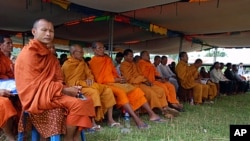Cambodia’s Khmer Rouge tribunal is often in the news for the wrong reasons - funding problems, delays and allegations of political interference, to name a few.
But although the judicial progress is slow, the Phnom Penh-based court continues to spread its message around the country, most recently in the former Khmer Rouge stronghold of Samlaut in western Cambodia.
Samlaut district has a long association with the Khmer Rouge. It was here in 1967 that the initial uprising took place which ultimately culminated in the rule of Pol Pot’s government between 1975 and 1979 and the deaths of around two million people.
But the end of Khmer Rouge rule in 1979 did not mark the end of the movement. Propped up by Thailand, China and Western nations such as the United States, the Khmer Rouge ran their civil war from an arc of districts in western Cambodia.
Samlaut was one of those areas. It remained under Khmer Rouge control until the late 1990s when the movement finally collapsed in the aftermath of the Soviet Union’s demise.
The U.N.-backed war crimes tribunal was created to bring some sense of justice to victims of the Khmer Rouge. But its creation took years of negotiations with Cambodian authorities who wanted to control the process. The tribunal is modeled on the French legal system and includes local judges and international judges who are approved by both the U.N. and Cambodia.
The Khmer Rouge tribunal tasked with prosecuting former leaders and those most responsible is understandably not popular in places like this, where some see it as the embodiment of victors’ justice.
Court spokesman Lars Olsen, who visited Samlaut last week with the tribunal’s outreach team, says that provides a good reason for court representatives to visit.
“I’m pleased that a relatively large number of people turned up and that after some hesitation at least they chose to air some of their thoughts about the court process," Olsen said. "And as one could have expected from an area like this that is inhabited by a lot of former Khmer Rouge, they have reservations about the court process and they also expressed this view very clearly.”
Around 200 residents attended, sitting on plastic chairs under a multicolored tarpaulin.
What they hear is straightforward enough: an explanation of how the court works, and discussion about its cases, including the tribunal’s first against the Khmer Rouge jailer Comrade Duch, who used to live in Samlaut.
Six court staff made the 350-kilometer trip to Samlaut, including Deputy Prosecutor Vincent De Wilde d'Estmael.
It fell to him to explain the role of the prosecution.
“Our goal is to end the impunity regarding the crimes that were committed in the Democratic Kampuchea period," he explained. "Impunity has lasted too long. And, second, we would like that the truth is found about those crimes and that justice is rendered to the numerous Cambodian people who were victims of the crimes committed.
It’s a message that frankly goes down better in non-Khmer Rouge areas of Cambodia.
In Samlaut, residents said the tribunal was within its rights to prosecute the senior leaders, but nobody else. This man said that trying others could undermine peace and stability.
That closely echoes the government’s opinion. Cambodia’s Prime Minister Hun Sen has long said he will not permit the prosecution of five mid-ranking Khmer Rouge cadres whom the tribunal is investigating.
Olsen says in other parts of Cambodia people cannot understand how so few can be tried for such extraordinary crimes. “That’s obviously not the case here. It was very much a focus of: Why do this now? Why jeopardize the achievements they have had since the peace? And is this some kind of revenge? And, of course, it’s important for us to hear these concerns and also be able to address them," he said.
To date, the tribunal has held about a dozen public forums around the country. Most are targeted at victims of the Khmer Rouge.
This outreach in Samlaut was the second to focus on a former Khmer Rouge stronghold.
As the court gears up for the start next year of Case Two, the trial of the senior leaders, there will be many visits like this to make sure Cambodians on both sides of the divide are kept informed.





